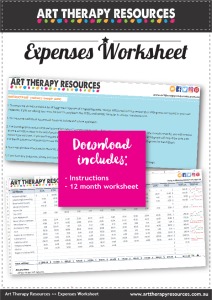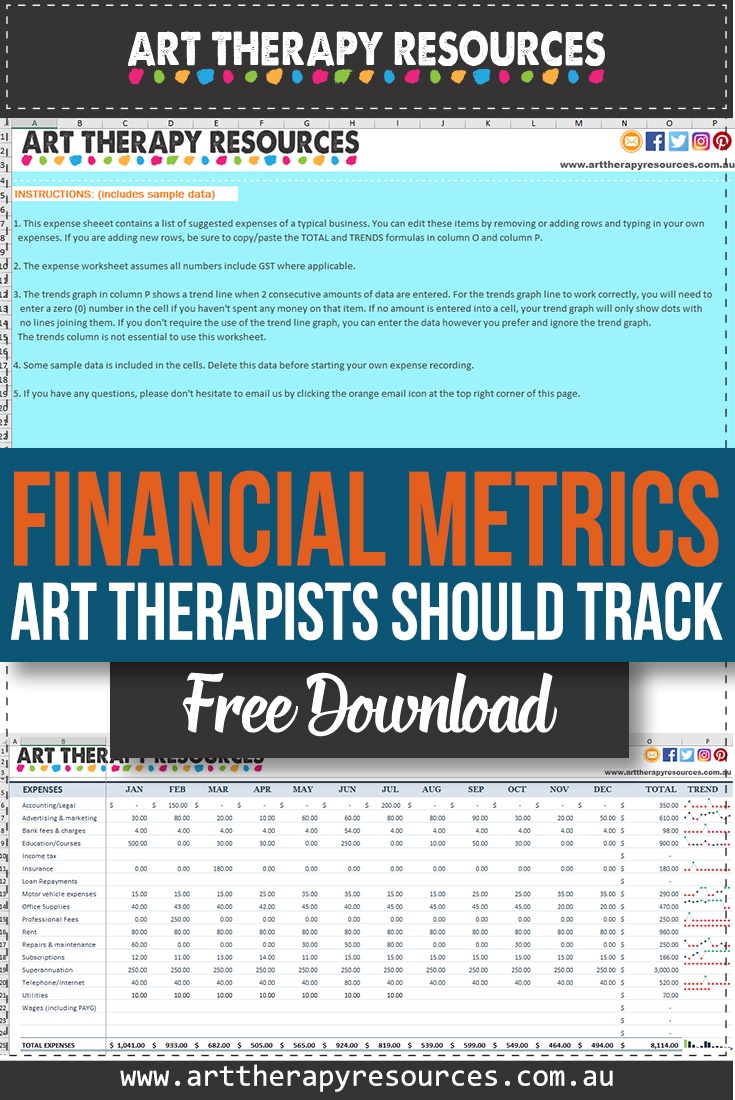THIS POST INCLUDES:
1. Revenue Metrics
2. Expense Metrics
3. Profitability Metrics
4. Free Download Expense Tracker
Revenue Metrics
Art therapists navigate a complex interplay of clinical work and business management. While the primary focus remains on providing therapy services, the sustainability and growth of a practice rely on its financial health. Understanding and tracking key financial metrics is a strategic task that helps art therapists to make informed decisions, optimize operations, and enhance their capacity to serve clients effectively. We will explore critical indicators across revenue, expenses, and profitability, providing practical strategies for integration into daily practice, supervision, and professional development.
Topic 1: Revenue Metrics
Revenue metrics are fundamental to understanding the income generation of your art therapy practice. Tracking these metrics provides insights into client engagement, service utilization, and pricing strategies.
Key revenue metrics include:
1. Average Revenue Per Client (ARPC)
Average Revenue Per Client (ARPC) is a crucial metric that indicates the average income generated from each client over a specific period. This metric helps in assessing the value of your client relationships and can inform pricing adjustments or service package development. To calculate ARPC, divide your total revenue by the number of unique clients served within a given timeframe. For example, if your practice generated $10,000 in a month from 50 unique clients, your ARPC would be $200. Monitoring ARPC allows art therapists to identify trends in client spending and evaluate the effectiveness of their service offerings.
2. Client Retention Rate
Client retention rate measures the percentage of clients who continue to engage with your services over a defined period. A high retention rate signifies client satisfaction and the effectiveness of your therapeutic interventions. Conversely, a low retention rate may indicate issues with client engagement, treatment outcomes, or practice management. To calculate client retention, subtract the number of new clients acquired during a period from the total number of clients at the end of the period, divide by the number of clients at the beginning of the period, and multiply by 100. For instance, if you started with 100 clients, gained 20 new clients, and ended with 90 clients, your retention rate would be ((90 – 20) / 100) * 100 = 70%. Strategies to improve client retention include consistent follow-up, personalized care, and soliciting client feedback.
3. Appointment Volume and Utilization Rate
Appointment volume refers to the total number of sessions conducted within a specific period, while the utilization rate measures the percentage of available appointment slots that are filled. These metrics are vital for assessing the operational efficiency of your practice. A low appointment volume or utilization rate may suggest a need for enhanced marketing efforts, adjustments to scheduling, or a review of client acquisition strategies. To calculate utilization rate, divide the number of actual appointments by the total number of available appointment slots and multiply by 100. For example, if you had 100 available slots and filled 75, your utilization rate is 75%. Optimizing these metrics ensures that your time and resources are effectively utilized, maximizing your practice’s earning potential.
Expense Metrics
Managing expenses is as critical as generating revenue for the financial health of your art therapy practice. Effective expense tracking allows you to identify areas for cost reduction, improve efficiency, and ultimately increase profitability.
Key expense metrics include:
1. Expense-to-Revenue Ratio
The Expense-to-Revenue Ratio is a direct measure of how much of your revenue is consumed by expenses. This ratio is calculated by dividing your total expenses by your total revenue and multiplying by 100 to get a percentage. For example, if your total expenses for a month were $4,000 and your total revenue was $10,000, your expense-to-revenue ratio would be 40%. A lower ratio indicates better financial efficiency. Monitoring this metric helps art therapists understand the proportion of their income that goes towards operating costs and can highlight areas where spending might be excessive or inefficient. Regularly reviewing this ratio can guide decisions on overhead reduction, such as optimizing office space, renegotiating vendor contracts, or streamlining administrative processes.
2. Fixed vs. Variable Costs
Understanding the distinction between fixed and variable costs is essential for financial planning and control. Fixed costs are expenses that do not change regardless of the number of clients you serve or sessions you conduct, such as rent, insurance premiums, and subscription fees for practice management software. Variable costs, on the other hand, fluctuate with the volume of your services, including art supplies, marketing expenses per client, or payment processing fees. By categorizing your expenses, you can better predict your financial obligations and identify opportunities to manage costs more effectively. For instance, reducing variable costs per session can directly improve your profit margins, while optimizing fixed costs can lower your break-even point.
3. Cost Per Session/Client
Calculating the cost per session or per client provides a granular view of the financial outlay associated with delivering your services. This metric helps in setting appropriate fees and understanding the true cost of providing art therapy. To determine the cost per session, divide your total expenses (or a portion of them, depending on what you want to analyze) by the number of sessions conducted. For example, if your total monthly expenses are $4,000 and you conduct 100 sessions, your cost per session is $40. This metric is particularly useful for evaluating the profitability of different service offerings or client types. By minimizing the cost per session without compromising the quality of care, art therapists can enhance their financial viability and ensure their services remain accessible and sustainable.
Profitability Metrics
Profitability metrics are an important indicator of your art therapy practice financial success. They reveal how efficiently your practice converts revenue into profit after accounting for all expenses. Tracking these metrics is helpful for long-term sustainability and growth.
Key profitability metrics include:
1. Profit Margin
Profit margin is a percentage that represents the proportion of revenue that remains after all expenses have been deducted. It is a direct measure of your practice’s financial health and efficiency. To calculate your profit margin, divide your net profit (revenue minus expenses) by your total revenue and multiply by 100. For instance, if your monthly revenue is $10,000 and your net profit is $6,000, your profit margin is 60%. A higher profit margin indicates better financial performance.
Art therapists should aim for a healthy profit margin to ensure sufficient funds for reinvestment in the practice, professional development, and personal financial security. Regularly analyzing your profit margin can help identify areas for improvement, whether through increasing revenue, reducing costs, or a combination of both.
2. Break-Even Point
The break-even point is the level of revenue at which your total costs equal your total revenue, resulting in neither profit nor loss. Understanding your break-even point is crucial for financial planning and setting realistic goals. To calculate the break-even point in terms of revenue, divide your total fixed costs by the difference between your per-unit revenue and per-unit variable costs (contribution margin per unit). Alternatively, you can calculate it in terms of the number of sessions needed to cover all costs. For example, if your fixed costs are $2,000 per month, and your average profit per session after variable costs is $50, you would need to conduct 40 sessions ($2,000 / $50) to break even. Knowing your break-even point helps art therapists determine the minimum number of clients or sessions required to cover operational expenses and begin generating profit. This metric is invaluable for setting pricing, managing capacity, and making strategic decisions about practice expansion or contraction.
3. Return on Investment (ROI)
Return on Investment (ROI) measures the profitability of an investment relative to its cost. In an art therapy practice, investments can include marketing campaigns, new equipment, professional training, or specialized art materials. ROI helps you evaluate whether these investments are generating a positive financial return. To calculate ROI, subtract the cost of the investment from the gain from the investment, divide by the cost of the investment, and multiply by 100. For example, if a marketing campaign cost $500 and resulted in an additional $1,500 in revenue, the ROI would be (($1,500 – $500) / $500) * 100 = 200%. A positive ROI indicates that the investment was worthwhile. Tracking ROI allows art therapists to make data-driven decisions about where to allocate resources, ensuring that investments contribute to the overall financial growth and success of the practice. This metric encourages a strategic approach to spending, focusing on initiatives that yield the greatest financial benefits.
Building and sustaining a private practice is a delicate blend of clinical passion and astute business acumen. While the heart of the work lies in facilitating healing and growth through creative expression, the backbone of a thriving practice is its financial health. By diligently tracking essential financial metrics, from revenue indicators like Average Revenue Per Client and Client Retention Rate, to expense management through Expense-to-Revenue Ratios and cost analysis, and finally to profitability measures such as Profit Margin, Break-Even Point, and Return on Investment, art therapists can gain unparalleled clarity into their practice’s performance.
This financial literacy empowers therapists to make strategic decisions, optimize resource allocation, and ensure the long-term viability of their invaluable services. Embracing these metrics provides financial oversight as a powerful tool for professional development, therapeutic planning, and effective supervision. Ultimately, a financially sound practice is better equipped to expand its reach and continue offering important art therapy services to those who need it most.
FREE DOWNLOAD: Art Therapy Exercise
SIGN UP below to gain access to our RESOURCE LIBRARY and download the FREE Expenses Spreadsheet

BUILD YOUR ART THERAPY REFERENCE MATERIALS:
Pin this image to your Pinterest board.

SHARE KNOWLEDGE & PASS IT ON:
If you’ve enjoyed this post, please share it on Facebook, Twitter, Pinterest. Thank you!
